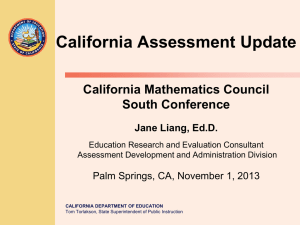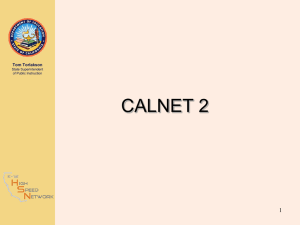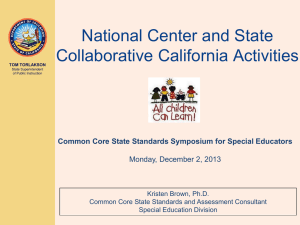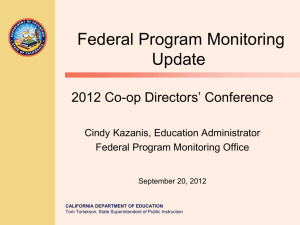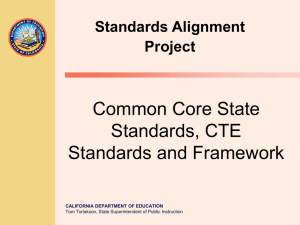Transitioning to the Common Core State Standards, What you Can
advertisement
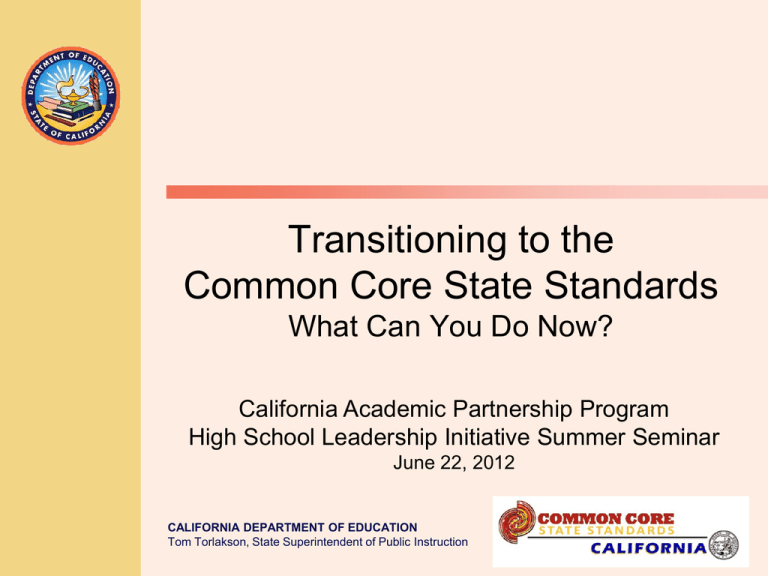
Transitioning to the Common Core State Standards What Can You Do Now? California Academic Partnership Program High School Leadership Initiative Summer Seminar June 22, 2012 CALIFORNIA DEPARTMENT OF EDUCATION Tom Torlakson, State Superintendent of Public Instruction Today’s Workshop TOM TORLAKSON State Superintendent of Public Instruction • Brief history of the standards • Overview and resources for mathematics • Overview and resources for English language arts and literacy • Overview and resources for assessment • Questions and answers 2 College and Career Readiness Standards TOM TORLAKSON State Superintendent of Public Instruction • In 2009, the Council of Chief State School Officers (CCSSO) and the National Governors Association Center for Best Practices (NGA Center) committed to developing a set of standards that would help prepare students for success in college and career. • In September 2009, College and Career Readiness standards were released. • This work became the foundation for the Common Core. 3 The Common Core State Standards TOM TORLAKSON State Superintendent of Public Instruction • Feedback and review from national organizations, including: – – – – – – – – American Council on Education American Federation of Teachers Campaign for High School Equity Conference Board of the Mathematical Sciences Modern Language Association National Council of Teachers of English National Council of Teachers of Mathematics National Education Association 4 The Common Core State Standards TOM TORLAKSON State Superintendent of Public Instruction Benefits: • Internationally benchmarked • Evidence and research-based • Consistent expectations – no matter where you live • Opportunity for shared resources and reduced costs 5 California and the Common Core State Standards TOM TORLAKSON State Superintendent of Public Instruction Senate Bill 1 from the Fifth Extraordinary Session (SB X5 1): – established an Academic Content Standards Commission (ACSC) to develop standards in mathematics and English– language arts – stated that 85 percent of the standards were to consist of the CCSS with up to 15 percent additional material – directed the State Board of Education to adopt or reject recommendations of the 6 ACSC TOM TORLAKSON State Superintendent of Public Instruction Source: http://www.corestandards.org/in-the-states 7 TOM TORLAKSON State Superintendent of Public Instruction Source: http://www.cde.ca.gov/re/cc/ 8 TOM TORLAKSON State Superintendent of Public Instruction 9 TOM TORLAKSON State Superintendent of Public Instruction 10 Common Core State Standards for Mathematics TOM TORLAKSON State Superintendent of Public Instruction The standards for mathematics: • are focused, coherent, and rigorous • aim for clarity and specificity • stress conceptual understanding of key ideas • balance mathematical understanding and procedural skill • are internationally benchmarked 11 Mathematical Proficiency as defined by the California Framework (2006) TOM TORLAKSON State Superintendent of Public Instruction Conceptual Understanding DOING MATH Problem Solving Procedural Skills 12 Two Types of Interrelated Standards TOM TORLAKSON State Superintendent of Public Instruction Mathematical Practices (the same at every grade level) Mathematical Content (different at each grade level) 13 Standards for Mathematical Practice TOM TORLAKSON State Superintendent of Public Instruction Describe ways students engage with the subject matter throughout the elementary, middle, and high school years 1. Make sense of problems and persevere in solving them. 2. Reason abstractly and quantitatively. 3. Construct viable arguments and critique the reasoning of others. 4. Model with mathematics. 5. Use appropriate tools strategically. 6. Attend to precision. 7. Look for and make use of structure. 8. Look for and express regularity in repeated 14 reasoning. CCSS Domains K–5 Domain K 1 2 3 4 5 Counting and Cardinality (CC) Operations and Algebraic Thinking (OA) Number and Operations in Base Ten (NBT) Measurement and Data (MD) Geometry (G) TOM TORLAKSON State Superintendent of Public Instruction Number and Operations – Fractions (NF) 15 CCSS Domains 6–8 6 7 Ratios and Proportional Relationships (RP) The Number System (NS) Expressions and Equations (EE) Geometry (G) Statistics and Probability (SP) Domain 8 TOM TORLAKSON State Superintendent of Public Instruction Functions (F) 16 High School Mathematics TOM TORLAKSON State Superintendent of Public Instruction The CCSS high school standards are organized in 6 conceptual categories: – Number and Quantity – Algebra – Functions – Modeling (*) – Geometry – Statistics and Probability California additions: – Advanced Placement Probability and Statistics – Calculus Modeling standards are indicated by a (*) symbol. Standards necessary to prepare for advanced courses 17 in mathematics are indicated by a (+) symbol. High School Mathematics TOM TORLAKSON State Superintendent of Public Instruction Build a function that models a relationship between two quantities (F-BF) 1. Write a function that describes a relationship between two quantities. * a. Determine an explicit expression, a recursive process, or steps for calculation from a context. b. Combine standard function types using arithmetic operations. For example, build a function that models the temperature of a cooling body by adding a constant function to a decaying exponential, and relate these functions to the model. c. (+) Compose functions. For example, if T(y) is the temperature in the atmosphere as a function of height, and h(t) is the height of a weather balloon as a function of time, then T(h(t)) is the temperature at the location of the weather balloon as a function of time. 18 Conceptual Category Overview TOM TORLAKSON State Superintendent of Public Instruction 19 Format of High School Standards TOM TORLAKSON State Superintendent of Public Instruction Conceptual Category Domain Standard Cluster 20 TOM TORLAKSON State Superintendent of Public Instruction Source: http://www.corestandards.org/the-standards/ 21 Model Course Pathways for Mathematics TOM TORLAKSON State Superintendent of Public Instruction Courses in higher level mathematics: Precalculus, Calculus (upon completion of Precalculus), Advanced Statistics, Discrete Mathematics, Advanced Quantitative Reasoning, or other courses to be designed at a later date, such as additional career technical courses. Algebra II Mathematics III Geometry Mathematics II Algebra I Mathematics I Pathway A Pathway B Traditional in U.S. International Integrated approach 22 (typical outside of U.S.) Transitioning to the CCSS TOM TORLAKSON State Superintendent of Public Instruction 1. Focus strongly where the Standards focus 2. Coherence: Think across grades, and link to major topics within grades 3. Rigor: In major topics, pursue conceptual understanding, procedural skill and fluency, and application Source: http://www.achievethecore.org/ 23 TOM TORLAKSON State Superintendent of Public Instruction Source: http://insidemathematics.org/ 24 TOM TORLAKSON State Superintendent of Public Instruction Source: http://illustrativemathematics.org/ 25 TOM TORLAKSON State Superintendent of Public Instruction Source: http://commoncoretools.me/ 26 What Can You Do Now? TOM TORLAKSON State Superintendent of Public Instruction • Identify 3 steps your school community can take now to support implementation of the Common Core State Standards for Mathematics. 27 Literacy Standards TOM TORLAKSON State Superintendent of Public Instruction • Literacy standards for grade 6 and above are predicated on teachers of ELA, history/social studies, science and technical subjects using their content area expertise to help students meet the challenges of reading, writing, listening, speaking and language in our respective fields. 28 Literacy Standards TOM TORLAKSON State Superintendent of Public Instruction It is important to note that the 6-12 LITERACY standards in history/social studies, science, and technical subjects are not meant to replace content standards in those areas but rather to SUPPLEMENT them! 29 Fundamental Differences in Literacy Standards TOM TORLAKSON State Superintendent of Public Instruction • Literacy across-the-curriculum • Spotlight on text complexity • New grounding in informational texts (from 50:50 to 75:25) • Writing about texts (drawing evidence from texts) • Particular emphasis on marshaling arguments • Conducting short, focused research projects • Focus on academic vocabulary • Evidence, evidence, evidence! S. Pimentel, Primary Author CCSS 30 Major Shifts in Literacy Instruction TOM TORLAKSON State Superintendent of Public Instruction • An emphasis on text complexity and the language and vocabulary of complex text. • A new focus on reading and writing grounded in evidence from text. • A focus on building knowledge through increased content reading. 31 CCSS GOALS for LEARNING TOM TORLAKSON State Superintendent of Public Instruction CAREER Ready and COLLEGE Ready and LIFE Ready 32 Text Complexity Defined by Three Factors TOM TORLAKSON State Superintendent of Public Instruction 1. Quantitative measures: word length, word frequency, word difficulty, sentence length, text length and cohesion 2. Qualitative measures: levels of meaning, structure, language conventionality and clarity, and knowledge demands measured by an attentive reader 3. Reader and Task considerations: background knowledge, interests, motivation, “grade levels of content,” assigned tasks 33 Meaning: Text Dependent Questions and Tasks TOM TORLAKSON State Superintendent of Public Instruction • Can be addressed only through careful scrutiny of the text and do not rely on outside information • Students draw evidence from the text and explain the evidence (orally and in writing) • Students demonstrate understanding of what is read before engaging opinions, evaluations, or interpretations 34 Appendix A TOM TORLAKSON State Superintendent of Public Instruction Research Supporting Key Elements of the ELA Standards Including: – Complexity of Texts – Foundational Skills – Writing – Speaking and Listening – Language – Glossary of Key Terms 35 Appendix B: Text Exemplars TOM TORLAKSON State Superintendent of Public Instruction • Includes examples by grade level with sample performance tasks • Stories, poetry, drama, and informational text • Gives teachers an idea of achievement expectations for each grade level • Includes examples for History/Social Studies, Science, and Technical Subjects 36 Appendix C: Samples of Student Writing TOM TORLAKSON State Superintendent of Public Instruction • samples of student writing for each grade level with annotation describing what the writer did well. 37 Writing Standards TOM TORLAKSON State Superintendent of Public Instruction “The Common Core Standards require students to show that they can analyze and synthesize sources and present careful analysis, well defended claims and clear information.” “…the writing standards…require students to draw evidence from a text or texts to support analysis, reflection or research.” Source: Draft Publisher’s Criteria for the Common Core State Standards in ELA & Literacy, Grades 4-12 38 Writing Types and Purposes TOM TORLAKSON State Superintendent of Public Instruction NAEP Writing Framework Foundation Purposes for and Recommended Writing Types Grade To Persuade To Explain To Convey Experience 4 30% 35% 35% 8 35% 35% 30% 12 40% 40% 20% Source: National Assessment Governing Board. (2007). Writing framework for the 2011 National Assessment of Educational Progress, http://www.nagb.org/publications/frameworks/writing2011.doc 39 Range of Writing TOM TORLAKSON State Superintendent of Public Instruction Write routinely over extended time frames (time for research, reflection, and revision) and shorter time frames (a single sitting or a day or two) for a range of discipline- specific tasks, purposes, and audiences. (2-12.W.10) 40 Speaking and Listening Standards TOM TORLAKSON State Superintendent of Public Instruction “…engaging discussions around grade level topics and texts that students have studied and researched in advance.” “…strengthening students listening skills as well as their ability to respond to and to challenge their peers with relevant follow up questions and evidence.” Source: Draft Publisher’s Criteria for the Common Core State Standards in ELA & Literacy, Grades 4-12 41 Language Standards TOM TORLAKSON State Superintendent of Public Instruction “…gain adequate mastery of the essential “rules” of standard written and spoken English.” “…learn how to approach language as a matter of craft so they can communicate clearly and powerfully.” Source: Draft Publisher’s Criteria for the Common Core State Standards in ELA & Literacy, Grades 4-12 42 TOM TORLAKSON State Superintendent of Public Instruction Literacy in History/Social Studies, Science, and Technical Subjects • Builds upon the same anchor standards for reading and writing • Includes a focus on discipline-specific vocabulary • Acknowledges the unique text structures found in informational text • Focuses on expectation that students will develop content knowledge AND informational/technical writing skills 43 Technical Subjects TOM TORLAKSON State Superintendent of Public Instruction Technical subjects – A course devoted to a practical study, such as engineering, technology, design, business, or other workforce-related subject; a technical aspect of a wider field of study, such as art or music Source: Common Core State Standards for English Language Arts and Literacy in History/Social Studies, Science and Technical Subjects: Appendix A 44 Reality Check: Increase Teacher Collaboration TOM TORLAKSON State Superintendent of Public Instruction • Interdisciplinary planning – Allows for multiple points of access to subject matter – Deepens student understanding of content – Ensures adequate reading and writing of informational text 45 Meeting English Learners’ Needs TOM TORLAKSON State Superintendent of Public Instruction • Approximately 25% of California students are English learners. • Many CCSS support English language development. • The CCSS set rigorous grade-level expectations. • They assert that all students should be held to the same high expectations. 46 Common Core: Important Skills for English Learners TOM TORLAKSON State Superintendent of Public Instruction • Apply knowledge of language to understand how language functions in different contexts, to make effective choices for meaning and style, and to comprehend more fully when reading or listening. Knowledge of language should include: – Pragmatic knowledge--knowledge of language use in context (status/purpose of speaker, genre structures) – Linguistic knowledge--knowledge of the functional demands of writing and speaking (e.g., formulate questions, compare/contrast, summarize, draw conclusions • Recognize variations from standard English in their own and others’ writing and speaking and identify and use strategies to improve expression in conventional language Source: Diane August, Center for Applied Linguistics 47 TOM TORLAKSON State Superintendent of Public Instruction 48 TOM TORLAKSON State Superintendent of Public Instruction 49 Implications For Your Team TOM TORLAKSON State Superintendent of Public Instruction • So What? Now What? • What do you already do that is interdisciplinary in nature? • Think about ‘piloting’ some tasks, units, common reading and writing activities and review student work together next year. • What can you do to learn more and practice some of the ideas from others? 50 California Joins SMARTER Balanced Assessment Consortium TOM TORLAKSON State Superintendent of Public Instruction • On June 9, 2011 California joined the SMARTER Balanced Assessment Consortium (SBAC) – Memorandum of Understanding signed by Superintendent Torlakson, Governor Brown, and State Board of Education President Micheal Kirst – Governing state role • Decision-making capacity 51 SBAC Landscape TOM TORLAKSON State Superintendent of Public Instruction • 27 states representing 43% of K-12 students • 21 governing, 6 advisory states Using Computer Adaptive Technology for Summative and Interim Assessments TOM TORLAKSON State Superintendent of Public Instruction Faster results • Turnaround in weeks compared to months today Shorter test length • Fewer questions compared to fixed form tests Increased precision • Provides accurate measurements of student growth over time Tailored to student ability • Item difficulty based on student responses Greater security Mature technology • Larger item banks mean that not all students receive the same questions • GMAT, GRE, COMPASS (ACT), Measures of Academic Progress (MAP) 53 Assessment System Components TOM TORLAKSON State Superintendent of Public Instruction Summative Assessment • Assesses the full range of Common Core in English language arts and mathematics for students in grades 3–8 and 11 (interim assessments can be used in grades 9 and 10) • Measures current student achievement and growth across time, showing progress toward college and career readiness • Can be given once or twice a year (mandatory testing window within the last 12 weeks of the instructional year) • Includes a variety of question types: selected response, short constructed response, extended constructed response, technology enhanced, and performance tasks 54 Assessment System Components TOM TORLAKSON State Superintendent of Public Instruction Interim Assessment • Optional comprehensive and content-cluster assessment to help identify specific needs of each student • Can be administered throughout the year • Provides clear examples of expected performance on Common Core standards • Includes a variety of question types: selected response, short constructed response, extended constructed response, technology enhanced, and performance tasks • Aligned to and reported on the same scale as the summative assessments • Fully accessible for instruction and professional development 55 Assessment System Components TOM TORLAKSON State Superintendent of Public Instruction Performance Tasks • Extended projects demonstrate real-world writing and analytical skills • May include online research, group projects, presentations • Require 1-2 class periods to complete • Included in both interim and summative assessments • Applicable in all grades being assessed • Evaluated by teachers using consistent scoring rubrics 56 Assessment System Components TOM TORLAKSON State Superintendent of Public Instruction Formative Assessment Practices • Research-based, on-demand tools and resources for teachers • Aligned to Common Core, focused on increasing student learning and enabling differentiation of instruction • Professional development materials include model units of instruction and publicly released assessment items, formative strategies 57 Assessment System Components TOM TORLAKSON State Superintendent of Public Instruction Online Reporting •Static and dynamic reports, secure and public views •Individual states retain jurisdiction over access and appearance of online reports •Dashboard gives parents, students, practitioners, and policymakers access to assessment information •Graphical display of learning progression status (interim assessment) •Feedback and evaluation mechanism provides surveys, open feedback, and vetting of materials 58 More SBAC Information TOM TORLAKSON State Superintendent of Public Instruction For more information, visit the CDE SBAC Web page at http://www.cde.ca.gov/ta/tg/sa /smarterbalanced.asp Contact: Kristen Brown, PhD SBAC State Coordinator kbrown@cde.ca.gov 916-319-0334 59 Subscribe: TOM TORLAKSON State Superintendent of Public Instruction join-commoncore@mlist.cde.ca.gov subscribe-sbac@mlist.cde.ca.gov Contact us: commoncoreteam@cde.ca.gov Nancy Brownell 916-319-0693 Barbara Murchison 916-319-0490 60

